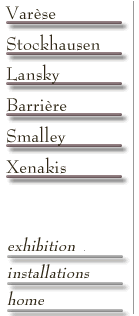


|
Iannis Xenakis was born in Braïla, Romania in 1922. His family moved back to their native Greece in 1932. Xenakis began composition lessons at the age of 12 and studied music intermittently during his engineering studies at the Athens Polytechnic. His university years were largely interrupted by the events of World War II. The year he entered the Polytechnic, 1940, was also the year that Italy invaded Greece. Xenakis became increasingly active in the student demonstrations of the Greek Resistance and was incarcerated several times. He was eventually forced to go into hiding after being sentenced to death by the government. In 1945, Xenakis suffered a shell wound to his face that disabled his left eye. After the war, Xenakis planned to flee to the United States. His stopover in Paris, however, became a permanent one. In 1947, Xenakis was hired by the famed architect Le Corbusier as an engineering assistant and helped design, among other projects, the Philips Pavilion for the 1958 Brussels World's Fair. Xenakis concedes, however, that he was more interested in studying composition than in being an architect during this time. A series of auspicious meetings enabled Xenakis to pursue that interest. He briefly studied with Arthur Honegger and Darius Milhaud, and was later referred to Olivier Messiaen in 1951. Messiaen encouraged Xenakis's uncommon background in architecture and mathematics, saying, "Take advantage of these things. Do them in your music." Conductor Hermann Scherchen, who would become a lifelong confidant and supporter of Xenakis's music, said the following when he first encountered Xenakis's music in Paris, "I find it interesting that you don't approach music as a musician. You look at it from a different point of view, from the outside." Xenakis, whose name means "gentle stranger," became a French citizen in 1965. Xenakis began adapting principles of mathematics and probability to his instrumental music around 1954. Works such as Metastasis (1953-4), Pithoprakta (1955-6) and Eonta (1963-4) were composed according to these principles, an approach Xenakis called stochastic music. The premiere of Metastasis at the Donaueschingen Festival in 1955 drew criticism particularly from the serialists who described the work as "protoplasm-like" and "crammed with |
glissandos." Xenakis answered his critics in a bold article that same year, "The Crisis of Serial Music," in which he articulated his formalized techniques. In his stochastic works, statistical methods were used at every level of the musical process, from score composition to sound synthesis. Xenakis also pioneered a unique approach for using the same mathematical procedures in creating both the micro- and macrostructure in electroacoustic music. From 1957 to 1962 Xenakis composed at Pierre Schaeffer's electronic studio. In the electroacoustic works he created there, Diamorphoses (1957-8), Concret PH (1958), Orient-Occident (1960), and Bohor (1962), Xenakis continued to explore a texture concept that he had been exploring in his instrumental works, what he calls "cloud" or "galaxy" technique, manifested by slowly evolving, granular sound masses in which the internal details are constantly moving, often by way of glissandi, repetition, or tremolo. Xenakis departed from the purer, more transparent appropriations of musique concrète that prevailed at Schaeffer's studio and instead explored the deeper structures of his sound materials, preferring extremely rich sounds or extremely faint sounds highly amplified. Bohor (1962) not only marked a new level of sound exploration but also a severe split between him and Schaeffer, though the work was dedicated to Schaeffer. Xenakis established the School of Mathematical and Automated Music in Paris (CEMAMu) in 1966 and later a sister institution at Indiana University. Xenakis has also created, among other things, a tool for writing electronic music called UPIC. He has taught at Tanglewood, Indiana University, and the Sorbonne. In addition to his orchestral and electroacoustic works, he has written several choral, dramatic, and chamber works, as well as sound and light shows known as polytopes. "That is the music of our age," said Varèse after hearing Xenakis's breakthrough work Metastasis.
More on Xenakis (a discussion with Xenakis at the Computer Music Festival in Delhpi, Greece).
|